Saturday, April 11, 2009
“Mo’ Money,” Less Wealth (Second update 4/14)
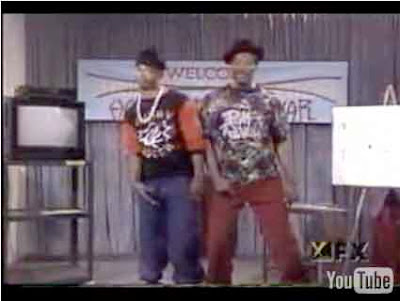
You get mo’ money from the Gub-MINT! Whiz and Ice, key economic advisers to the Obama regime (as well as its predecessor).
In comoedia veritas est.
In comedy, the truth is found.
As a 23-year-old “social organizer” in Chicago, Barrack Obama had an encounter that should have changed the way he looked at politics, were he in the habit of serious reflective thought.
Deployed as an Alinskyite “change agent” to Chicago’s South Side, Obama made the acquaintance of a redoubtable woman identified as “Sadie” in his first memoir, Dreams of My Father. Sadie is described as one of Obama’s “staunchest supporters” during his street-level work in pursuing what he calls “redistributive change.”
Sadie, like many other poor residents of Chicago’s inner city, wanted to believe in the gospel of statist wealth redistribution, but was somewhat weary of the way her grievances were being leveraged by those in charge of Chicago’s political spoils system.
So it likely was with a mixture of affection and despair that Sadie informed the eager and youthful future president: “Ain’t nothing gonna change, Mr. Obama. We just gonna concentrate on saving our money so we can move outta here as fast as we can.”
Now, if Obama had been blessed with an insightful older mentor — say, the equivalent of Sean Connery’s wizened Chicago beat cop Jimmy Malone from The Untouchables — that stern but kindly sage would have italicized the meaning of that moment (in a voice flavored with an endearing, albeit ethnically dubious, Caledonian brogue, of course):
“Barry, my boy, the key to real change and upward mobility is not to seize the earnings of the industrious and thrifty and lavish them on the corrupt and profligate. It’s to let people keep what they earn and use it to make life better for themselves and their children. That’s not The Chicago Way — but it is what we used to call The American Way. Here endeth the lesson.”
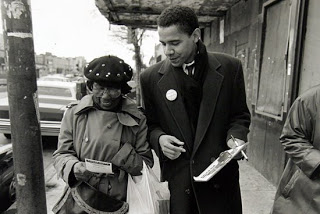 But, as Charles Glass documents in a terrific overview of Obama’s gestational years in the womb of the Chicago Machine, the would-be world-saver was both ideologically tone-deaf to the significance of such moments, and too beholden to the crass political establishment in the Big Onion, to change his trajectory.
But, as Charles Glass documents in a terrific overview of Obama’s gestational years in the womb of the Chicago Machine, the would-be world-saver was both ideologically tone-deaf to the significance of such moments, and too beholden to the crass political establishment in the Big Onion, to change his trajectory.
And now that he’s president, Obama — acting on behalf of the entrenched kleptocratic clique in control of our economy — is seeking to consummate “redistributive change” on a national basis by making it impossible for “Sadies” anywhere in the country to save what they earn and improve their circumstances.
To understand how this works, it’s useful to turn to the oeuvre of the Wayans Brothers, producers of the early 1990s sketch comedy program In Living Color — a program entirely uninhibited by politically correct etiquette.
Perhaps by virtue of their status as fully accredited minorities, they had what Seinfeld referred to as “total joke immunity”; this permitted them to examine, often in terms that would have made Rabelais blush, the comic-rich foibles of inner-city personality types. (Granted, the Wayans Brothers also inflicted Jim Carrey on the rest of us, and there are some things that simply cannot be forgiven.)
Not all of the Wayans Brothers’ targets were treated scornfully. One recurring sketch featured the Hedleys, the “hardest-working West Indian family” in the country. In this small but very energetic Jamaican household it is considered a stain on the family honor for someone to be working for fewer than a half-dozen employers. A man is judged by the number of jobs he can juggle simultaneously. Even toddlers are required to seek paying work as soon as they develop marketable motor skills.
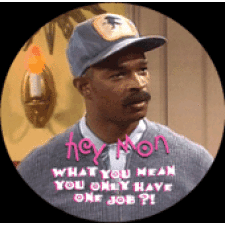
One installment find the older daughter aglow over the prospect of her date with a new beau, a wonderful man who makes more than $100,000 a year. That radiance quickly disappears however, when her prospects are occluded by parental disapproval; you see, her boyfriend is a doctor, which means that he only has one job.
At the other end of the spectrum from the eccentric but admirable Hedleys we find “Whiz” and “Ice,” a pair of petty crooks from the Hip-Hop anti-culture who consider themselves entrepreneurs and wealth-building consultants.
Where the immigrant Hedleys speak with a pronounced accent but precise, intelligible diction, the native-born Whiz and Ice converse in a patois — sub-Ebonics-level English punctuated with spastic hand gestures — that is perhaps a step above primal grunts and simian territorial antics. And while the Hedleys are busy earning money, Whiz and Ice are constantly exploring new ways to steal it. Their catchphrase will become quite obvious anon.
In the classic sketch depicting the “Homeboy Financial Seminar,” Whiz and Ice peddle their new booklet, “How to Make MO’ Money, Without Using YO’ Money.”
“Now, you might ask, `Whose money should I use?'” says Ice as he winds up for the sales pitch. “Well, who got mo’ money than they know what to do wid‘?”
“Da gub–MENT!” chimes in Whiz on cue.
With the practiced confidence of people who have lived their own advice, Ice and Whiz then give step-by-step instructions on how to use the Food Stamp program to leverage a six-pack of beer that costs $3.99 (“or even less, dependin‘ on the security system!” Whiz points out) into a $25 profit.
“Mo’ money, mo’ money, MO’ MONEY!” they exclaim.
They then present a few videotaped testimonials from people who have worked their program successfully — such as Anton “Boom-Boom” Geno, who made $45,000 in three weeks (before being locked away for 5-8 years); or Luther “Bighead” Jones, who scooped up $123,000 in six months (before being shot resisting arrest).
Whiz and Ice are creatures of pure consumption; they merely take and spend. The Hedleys are a caricature of upwardly mobile immigrants; all they do is work and save.
There is nothing new in this contrast; it’s as old as Aesop’s parable of the grasshopper and the ants. And, as the Wayans Brothers almost certainly understood as they created the characters, the allotment of such disparate character traits has nothing to do with melanin content or ethnicity (although culture undoubtedly plays a significant role).
Where industry and time preference are concerned, the Hedleys could have been immigrants from Korea, Latin America, India, the Pale of Settlement; they could have been 19th-Century sodbusters or 21st-century information entrepreneurs.
As for Whiz and Ice — well, they could be considered creatures from the collective Id of post-Bubble Wall Street.
The difference between the small-scale scam described in the “Homeboy Financial Seminar” and the more exotic species of fraud that prospered during the most recent Federal Reserve-engineered boom is entirely a matter of scale.
The securitized debts peddled by the likes of Goldman Sachs were a bit like a street hustler’s “flash roll” — an apparently impressive wad of cash that turns out to be a single large-denomination bill wrapped around a handful of fives and ones with a large core of blank paper sheets. The chief difference between a “flash roll” and a Collateralized Debt Obligation, for example, is that the latter is trash all the way through.
In a larger and more uncomfortable sense, however, Whiz and Ice symbolize our entire debt-based consumer economy since August 1971, when the dollar became a pure fiat currency.
America’s Empire of Debt, wrote William Bonner and Addison Wiggin in the indispensable book of that title (published on the eve of the unfolding financial melt-down) is “a vainglorious system of conceit, deceit, debt, and delusion…. Americans believe they can get rich by spending someone else’s money…. They believe that foreign countries actually want to be invaded and taken over. They believe they can run up debt forever, and that their debt-laden houses are as good as money in the bank.”
Or, to summarize the matter in a single pithy phrase, the entire system is based on the idea of “gettin‘ MO’ money, wid-out usin‘ YO money.”
One would think that the bloody debacles in Afghanistan and Iraq would disabuse Americans of the notion that other countries are simply aching to be invaded and occupied by the U.S. military. In similar fashion, one would think that the deepening horrors of our debt-based financial system would cause people to repent of the delusion that one can borrow his way to prosperity.
One would think this is the case. One would be wrong.
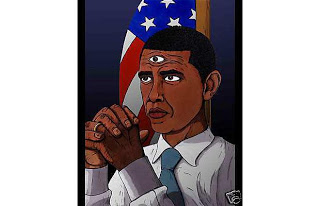
I’m tempted to say that the third eye is for “Inflation.” (Sorry.)
Witness the unedifying spectacle of Barrack Obama peddling his administration’s new subsidized mortgage refinancing program (no equity required, as long as your mortgage is backed by one of those twin exemplars of fiscal rectitude, Fannie Mae or Freddie Mac) with the unctuous pseudo-sincerity of a late-night infomercial pitchman.
But this is just one relatively small example of the Obama regime’s grand design for recovery, which is to “rescue” the economy by confiscating — through taxation or inflation — all the wealth earned by the Hedleys and delivering it into the hands of the Whizzes and Ices of Wall Street.
How is this to be accomplished?
Simple:
Mo’ money, mo’ money, MO’ MONEY! — that is, the Federal Reserve’s officially sanctioned counterfeit of the same.
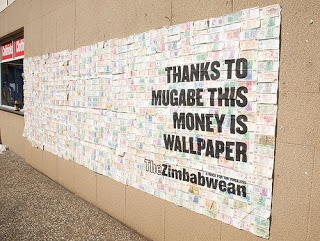
Since last September, the Treasury Department and Federal Reserve have spent, lent, or issued loan guarantees totaling $12.98 trillion. Last year’s Gross Domestic Product was $14.2 trillion.
This means that the Treasury and Fed, in order to service their Wall Street seraglio, have siphoned away the equivalent of nearly the entire U.S. economy.
In terms individualized impact, this exercise in corporate communism will cost $42,105 for every living American. (Of course, that computation doesn’t take into account the disparate impact those costs will have on the productive “Hedleys” versus the parasitical “Whizzes” and “Ices.”)
The total amount diverted into the rescue effort is fourteen times the $900 billion in U.S. currency presently in circulation. Monetizing that full amount — a likely outcome, now that the Fed is buying T-bills — would have some, ah, interesting social consequences. As the pitiful inhabitants of Zimbabwe can testify, “mo’ money” is hardly a blessing when a corrupt government simply emits an endless gusher of value-free paper scrip.
A quick note —
Versions of this document, a purported “Assessment” of “Rightwing Extremism” prepared by the “Extremism and Radicalization Branch” of the Department of Homeland Security,” have been circulating in the blogosphere for the past couple of days.
I’ve been trying to determine whether it is an official document or a decent forgery composed by someone with a perverse sense of humor. Presently, I’m waiting — most likely in vain — for some people to respond to telephone inquiries regarding the document and the mysterious DHS “Extremism and Radicalization Branch.”
Right now I’m inclined to treat this supposed report as a plausible fiction — perhaps a sharply written satire.
As soon as I learn anything substantial, I’ll certainly pass it along. Keep watching this space.
Second update: It Appears to be Authentic
The Washington Times this morning (April 14), in an article about the same “assessment” document, cited Homeland Security spokeswoman Sara Kuban by way of verifying its authenticity. Kuban describes it as “one in an ongoing series of assessments by the department to `facilitate a greater understanding of the phenomenon of violent radicalization in the U.S.”
Ah, the advantages that still accrue to the “old media”: I tried at least a half-dozen different ways to solicit a comment from the Homeland Security bureaucracy, and I’m still waiting for my most recent promised call-back.

Dum spiro, pugno!
Content retrieved from: http://freedominourtime.blogspot.com/2009/04/homeboy-recovery-plan.html.



























